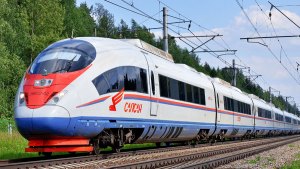Could Link With Proposed Helsinki Tunnel To Tallinn
Maksim Akimov, Russia’s Deputy Prime Minister stated at the Far East Economic Forum last week that Russia would like to extend the existing Moscow-St. Petersburg high-speed railway line to Finland in the future. “Surely as the second stage. We would like to extend the line to Helsinki, though that issue is to be negotiated with partners, that being an international project already,” he said, adding that there have been no political contacts regarding the issue so far.
The Moscow-St.Petersburg high speed train, or Sapsan, travels at about 240km an hours and take 4 hours to travel between destinations. Extending the route to Helsinki would mean high speed links between Moscow and Helsinki would take about 5.5 hours and about 90 minutes between St.Peterburg and Helsinki.
The position of Helsinki is an interesting one, as it is served either by short haul turbo prop flights from nearby cities such as Tallinn, Riga and St.Petersburg, or by ferries. As the city is a regional air hub, and a short route between Europe and Asia, its local regional connectivity from there remains problematic. A solution has been proposed that would see Helsinki linked with Tallinn, the capital of Estonia, by Tunnel, the so-called “hyper-loop.”
These developments are partially geared to accentuate the increasing amount of Chinese freight trains arriving in Europe via Kazakhstan and Russia, and to allow both Chinese and Russia trade access too and obtain supplies from the Baltics. At present, much of the rail traffic enters the EU into Poland via Belarus, further south, leaving the Baltics and Nordic nations out of the loop. Chinese-European freight is seeing a significant increase, partially due to the US-China trade war, with 6,300 freight trains making the journey in 2018. Such growth rates are only expected to continue. Coming Europe’s way are Chinese electronics, going the other – are valuable and perishable European consumables.
Getting the Baltics configured into this trade, both from the mutual access perspective as well as services provision, is also inspiring some serious infrastructure developments. Both Estonia and Finland are discussing the possibility of connecting to each other via a 90 km, Helsinki-Tallinn undersea tunnel. A one-way journey would take just 30 minutes, as opposed to an effective 3 hour (including airport time) trip to take the 60 minute Turboprop, and the 2 hours by ferry.
Helsinki and Tallinn jointly represent an economic area populated by 1.5 million people, and there is active inter-city movement of people for work and leisure as well as freight traffic. Last year, Tallinn processed 10 million port visitors, with Helsinki reporting 11.5 million marine passengers passing through. Traffic between the two port cities in particular saw major growth last year and tens of thousands embark on work-related trips between the two cities weekly. The EU-funded studies, which are being undertaken by a consortium of interested businesses, are expected to produce initial feasibility results later in the year. These are to include cost-benefit analyses and impact assessments for both the rail and marine options, how the undersea tunnel can be technically implemented, and price tag determinants for construction, maintenance, and rail traffic. It will also sketch out the project’s main features, including location of routes, stations, and rolling stock depots.
These are part of Rail Baltica, a greenfield rail transport infrastructure project intended to integrate the Baltic States in the European rail network. The project includes five European Union countries – Poland, Lithuania, Latvia, Estonia, and Finland. It will connect Helsinki, Tallinn, Pärnu, Riga, Panevežys, Kaunas, Vilnius, and Warsaw, and is expected to be completed by 2026. It would make sense therefore to link this with the proposed Moscow high-speed rail service to Helsinki, and bring in more Russian commercial business, in addition to allowing easier access to Moscow and St.Petersburg from the Baltic States. Rail has an advantage due to the stations being in city centres, reducing travel time from airports.
Much needs to be done to see an proposed St.Petersburg-Helsinki high-speed rail extension come to fruition. There will be numerous political debates. But for Helsinki to be connected, high-speed to Russia makes a lot of commercial sense. Whether the political anti-Russian bears or the Commercial pro-trade Russia bulls prevail will be an interesting exercise to watch.


Comment here